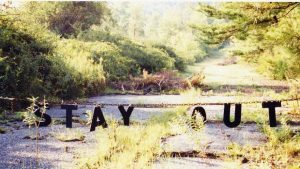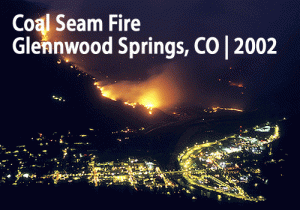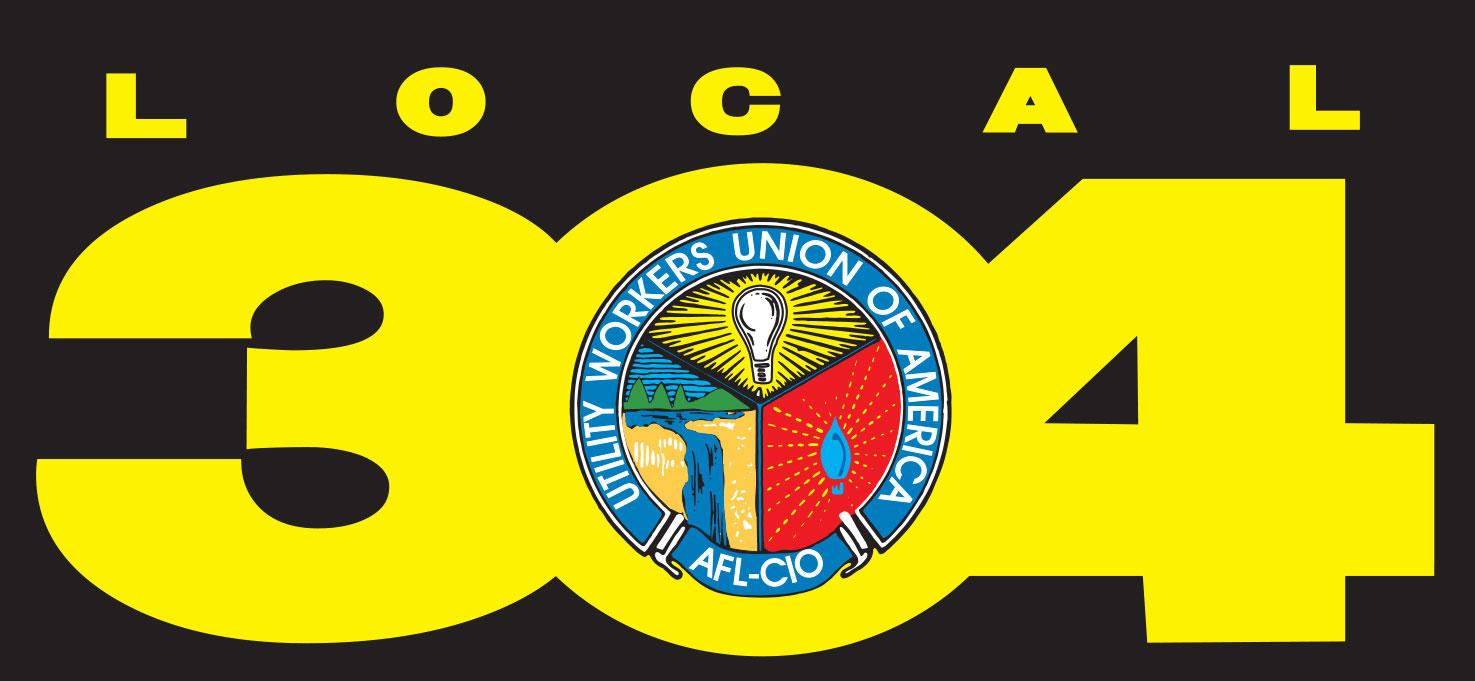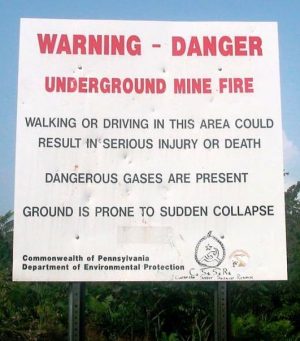Biggest Coal Polluter Isn’t Power Plants
Coal has been around forever, and thanks to new technology, better metering, and better scientific and engineering practices, it’s cleaner to burn than ever in our human history.
There is one coal user that is totally unregulated and free to burn without ANY of the safegaurds and processes used in the power industry and it’s the Earth!
There is a coal fire that has burned underground in Brennender Berg, Germany for over 300 years! The story starts in the year 1688, when a shepherd started a fire in a tree stump that burned to the roots, igniting a coal seam. The translation for the name of the town is, “Burning Mountain.”
Smoking Hills, Canada, is located close to the Artic Ocean, near Franklin Bay. John Franklin first explored the area in 1826, noting a haze that seemed to be hanging in the air. That haze was actually smoke from a chemical reaction between the lignite, sulphur, and oil shales in the area that caused spontaneous combustion.
 On the other side of the world is Burning Mountain, Australia, or Mount Wingen. Scientist speculate that this underground coal seam fire, that’s 2 meters thick, has been burning between 5.000-15,000 years.
On the other side of the world is Burning Mountain, Australia, or Mount Wingen. Scientist speculate that this underground coal seam fire, that’s 2 meters thick, has been burning between 5.000-15,000 years.
Closer to home is Centralia, PA, which lies outside of Wilkes-Barre, PA. The town decided to burn down it’s garbage dump in the early 1960’s. Little did they know that there was an exposed coal seam on one side of the piles of refuse. To make a long story short, the seam caught fire, the fire spread underground, and the town had to be abandoned in the mid 1980’s for the sake of public safety. The fire still burns today, over 50 years later.
On almost every continent on Earth, there are underground coal fires raging, unchecked, under the often serene and picturesque landscapes. According to the U.S. Geological Survey, between 10 and 200 million metric tons of coal is consumed annually by underground coal fires. The U.S. Department of the Interior Office of Surface Mining Reclamation and Enforcement spends a billion dollars a year on remediation efforts related to coal fires in our country’s 15 coal producing states.
 The real problem is that there is not one specific way to effectively fight underground coal fires. The best scientist can hope for is to identify where the fires are and then try to seal any vents to the surface they can find. They do this with ground penetrating radar and via heat seeking satellites.
The real problem is that there is not one specific way to effectively fight underground coal fires. The best scientist can hope for is to identify where the fires are and then try to seal any vents to the surface they can find. They do this with ground penetrating radar and via heat seeking satellites.
Underground coal fires represent a significant hazard to any life that lives above them. In St. Louis, there is an underground coal fire that is moving towards a nuclear waste dump. The nuclear material is the waste byproducts of America’s Manhattan Project from WWII. A lady in St. Louis developed alopecea, an auto-immune disease sometimes referred to as spot-baldness, claiming it was from the emmissions from the underground coal seam fire where she lives.
 In Glenwood, Colorado, an underground coal seam fire that has been burning for nearly a century reared it’s ugly head in 2002, setting thousands of acres of forest afire.
In Glenwood, Colorado, an underground coal seam fire that has been burning for nearly a century reared it’s ugly head in 2002, setting thousands of acres of forest afire.
Here locally, many locals can identify places that occasionally flare up from underground fires. One recently popped up beside Rt. 250, in White Hall. There’s another just over the hill from the power plant, just before the bridge at Gypsy, behind the log church. More sites can be found on the WV DEP’s website, under Office of Abandoned Mines Land and Reclamation.
The really puzzling thing is that there has been very little study as to the long term health effects and environmental impact of these fires by any agency, nor any patented and effective approaches to extinguishing these types of fires.
It is kind of hypocritical for the EPA and environmentalists to be so aggressive towards coal users and producers, when there are coal fires out there raging unchecked. It would seem to be common sense that a responsible and vibrant coal industry would be the best vangaurd for monitoring and understanding underground coal seam fires.
With all the hostility against coal powered generation, it makes you wonder if the objections raised by environmentalists are genuine concerns or just an avenue for revenue for those who claim to be against coal.
Afterall, the reclamation of mines and the extinguishing of such fires would accomplish removing tons of carbon pollution from the air, employ people in doing that work, and make such lands available for develpment. All of this would act to boost the economy and clean up the environment.
States With Stronger Unions Have Stronger Middle Class
“This material [article] was published by the Center for American Progress Action” (Click to go to their site)
By David Madland and Nick Bunker |
New Census Bureau data on state incomes released yesterday show just how important unions are to creating a strong middle class. An update to an analysis in our April 2011 report, “How Unions Make the Middle Class,” finds that a 10-percentage-point increase in the unionization rate would boost the average annual income for middle-class households—unionized or not—by $1,501 a year. Ensuring the United States has a strong middle class is critical, as the middle class is the engine of economic growth.
Unions strengthen the middle class by advocating for workers both in the workplace and in our democracy. Organized labor not only fights for higher wages and better benefits at work but it also makes democracy work for the middle class and advocates for policies that boost the middle class as a whole. As the new Census data make clear, stronger unions create a strong middle class not only at the national level but at the state level, as well.
In 2011, for example, the five states with the lowest unionization rates—North Carolina, South Carolina, Georgia, Arkansas, and Louisiana—all had middle classes with below-average strength, with strength defined as the share of income going to the middle 60 percent of households. Four out of the five states with the highest unionization rates—Alaska, Hawaii, Washington, and Michigan—all had middle classes with above-average strength.
The chart below shows the state-by-state impact of increasing unionization rates by 10 percentage points, returning them roughly to their 1980s levels. All middle-class households would feel the effects of this benefit, whether they have union members or not. These figures are based on a regression analysis that looks at how unionization rates affect the share of income going to the middle class, while taking into account other important factors such as education levels, unemployment, the income level of a state, and industry employment mix.
The boost from increased unionization is roughly equivalent to the $1,664-per-household boost from increasing college attainment rates by 10 percentage points. Improving educational outcomes and increasing access to higher education are correctly pointed out as important steps for bolstering the middle class, but, as our numbers show, we should not underestimate the importance of unions.
The American middle class has weakened over the past several decades and now receives the lowest share of income it ever has—45.7 percent—since the data were first collected in 1967. We can begin to rebuild our middle class, however, starting with these 35 policies. As our analysis shows, strengthening organized labor is one of the most important first steps.
David Madland is the Director of the American Worker Project at the Center for American Progress Action Fund. Nick Bunker is a Research Assistant with the Action Fund.



